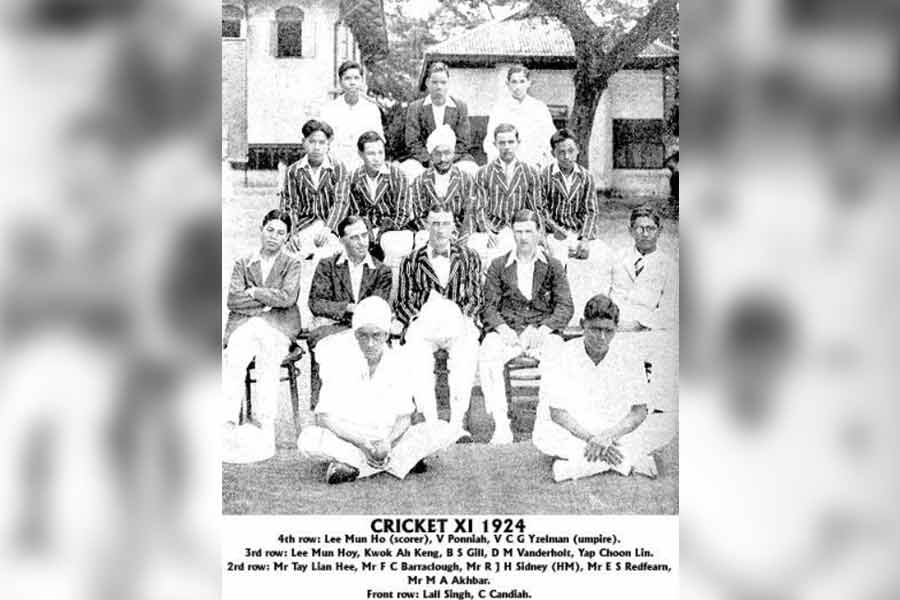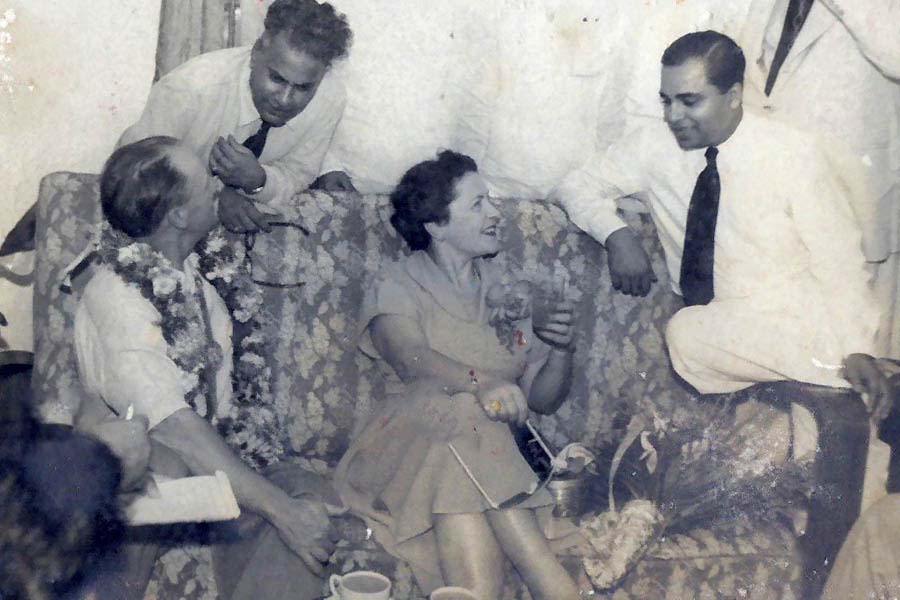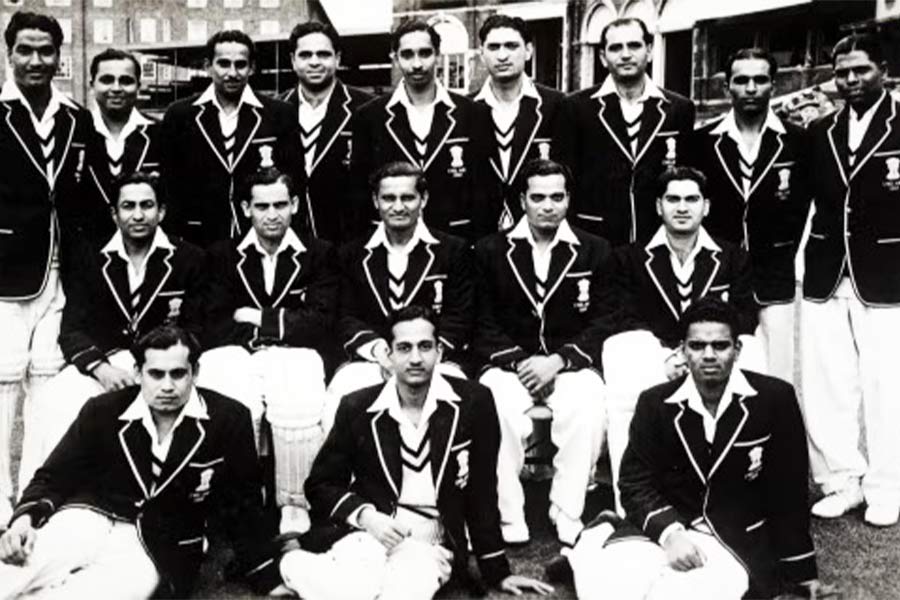What if I tell you that there was once an Indian cricketer who served a close confidant of one of India’s richest and most high-profile kings, regaled British spectators with his skills at the Lord’s Cricket Ground, owned a night club in Paris and lived for more than three years at a Japanese WWII prisoner camp? You’ll shake your head with incredulity in all likelihood, right? But this is not fiction. This is all true. This is the tale of an enigma called Lall.
Kuala Lumpur, British Malaya (present-day Malaysia). The Gills, an expatriate Indian family settled in the Malayas, was among the wealthiest around with ownership of mines, rubber plantations and multiple houses. In December, 1909, a third boy was born in the family and he was named Lall – Lall Singh Gill to give him his full name although he was popularly known as Lall Singh.

The Victoria Institution cricket team of 1924 Wikimedia Commons
Like his older brothers, Lall also found his way to the prestigious Victoria Institution. It was at Victoria that Lall’s talent at the game of willows first came to the fore. It was not just the runs but the manner in which he scored them – style, elegance and a flamboyant nonchalance – that made him darling of the crowds. Soon, reputation of Lall Singh the cricketer spread across the straits. In 1931, representing the Federated Malaya States against the Straits Settlements at The Padang cricket ground in Singapore, Lall played arguably his best knock – 131 breathtaking runs that had people gushing for days. That innings in particular would alter Lall Singh’s life.
Back at the time, cricket in India was largely the fiefdom of the royals. And the two men of blue blood who were battling it out for supremacy were the flamboyant Maharajah of Patiala, Bhupinder Singh, and PVA Gajapathi Raju, the Maharajkumar of Vizianagram. Both men, apart from being patrons of the fledgling Board of Control for Cricket in India (BCCI), also had their own cricket teams and were always on the lookout for the next big thing in the game to include in their teams. Thus, news came to Patiala about this Sikh cricketer from Malaya who was turning heads with his audacious stroke play. Bhupinder Singh immediately got things rolling and in 1931, Lall Singh arrived in Patiala.
Besides turning out for the Maharaja of Patiala’s cricket team, he would gradually become a close friend and confidant of the king, eventually functioning as the royal’s aide de camp. Bhupinder Singh was also a most flamboyant man with a love for all things in good life and in Lall, he found a kindred spirit. The royal after whom the iconic Patiala peg is named and the young man from Malaya spent many an evening together, accompanied by the tipple and other forms of entertainment, cementing a close bond. Meanwhile, history was preparing to make its tryst with Indian cricket.
In 1928, India had been admitted as a member of the Imperial Cricket Council (forerunner of ICC) and in the summer of 1932, the first official tour of England by the Indian team was announced. Like any young cricketer, Lall also dreamt of representing India. But there was a problem. He was neither born in India nor a resident of the country and by the MCC rules of the time, it made him ineligible to play for the Indian team. But back then, like now, having a powerful friend helped. Maharaja Bhupinder Singh was a chief patron of the BCCI and a special exception was made, allowing Lall Singh to fulfil his dream. He sailed off, along with the rest of the men for a historic tour.
June 25, 1932: Lord’s Cricket Ground. Colonel CK Nayudu led out the Indian team into the Test arena for the first time, Lall being one of the lucky XI. And it didn’t take him long to make a mark. The Englishmen had been jolted early by Mohammad Nissar who had dismissed Sutcliffe and Holmes cheaply. And then Lall took over. The legendary Frank Woolley set off for a quick single. Lall Singh moved in like a hawk, swooping in, picking up the ball and scoring a direct hit, and catching the great man short of the crease. England 19/3. A full house at Lord’s was left in shock and awe. An observer commented: “(Lall Singh) glides across the field like a snake.”

Maharaja Bhupinder Singh of Patiala Wikimedia Commons
With the bat however, Lall only provided a brief glimpse of his ability. After falling cheaply for 15 in the first innings, he played a quick and attractive hand of 29 the second time around, adding 74 in just 40 minutes in a whirlwind partnership with the famous allrounder L. Amar Singh.
That appearance at Lord’s would remain Lall’s only appearance in the Test arena. Given the momentousness of the occasion, he had been given an entry on exception basis. But now the rules would prohibit him playing for India gain. Lall though kept at his favourite game: playing in Malaya, for his patron Patiala’s team, for the Hindus in the Bombay Quadrangular, when the Ranji Trophy was started in 1934, turning out for Southern Punjab and even in an unofficial test for India against Jack Ryder’s Australian side. But his Patiala days would soon come to an abrupt and near-dead end.
By this time, Lall Singh was probably the king’s closest man and naturally, it invited the wrath of the court. Things became particularly tense after a murder attempt was made on him. Lall decided it was time, and after bidding goodbye to his benefactor, he moved to Bombay. Here, a romantic twist awaited him. Lall was a frequent visitor at the bar at Taj Mahal Palace Hotel. One day, he came across Myrtle Watkins, an African-American singer performing there and fell head over heels in love. Soon, Lall and Myrtle sailed for Paris, where Lall opened a nightclub with Myrtle as the star attraction. For a while, it seemed happily ever after. But in 1939, the couple broke off and a presumably heartbroken Lall returned to Malaya. The world soon blew up in flames.

Profiles of players, including Lall Singh’s (top left) Wikimedia Commons
Two years later, in December, 1941, war came to Malaya. After bombing Pearl Harbor, Imperial Japan moved in and occupied British Malaya. In middle of 1942, Lall Singh and his brothers were arrested for aiding British officers flee the country and their houses, land, rubber estates and gold mine were all confiscated. SS & BS Gill, Lall’s elder brothers, were hung to death, while Lall was sent to a prisoner camp in Borneo. There, he spent next three years, performing hard labour. The extremely inhumane conditions destroyed his health and he was left a skeletal reminder of his erstwhile good-looking self.
In August, 1945, in the aftermath of the atomic bombings, Japan was in a disarray. Taking advantage, Lall escaped and returned to Kuala Lumpur to reunite with his mother and two nieces, who had been provided shelter at the convent. Lall’s hair and beard had been shaved by his captors and he hadn’t grown it back. This along with his haggard form meant his mother failed to recognise him at first. But soon, there were enough tears of reunion. Lall now started looking for work. Once again, cricket provided a silver lining. He was hired as a groundsman at the Selangor Cricket Club. The man, who was once the darling of cricket fans in the Straits, was now earning his living in this humble way, unrecognised by anyone.
Lall’s luck finally changed in 1950, when the Sultan of Selangor, during a visit to the club, recognised him. He immediately ordered restoration of all family possessions of the Gill family. After long-drawn out legal procedures of nearly three years, the family got back most of what had been so cruelly snatched from them. It ensured Lall Singh’s late years were spent in reasonable comfort.
Lall probably never got over Myrtle. He never married and every summer, would make a trip to Paris, probably reminiscing his lost love. He had one last tryst with Indian cricket in 1980 when on the occasion of the Jubilee test to celebrate 50 years of the BCCI, the Board invited all ex-cricketers to Bombay. Lall travelled to the city where he had first found love and also met with a few old teammates from his playing days like Lala Amarnath.
He died in 1985.















